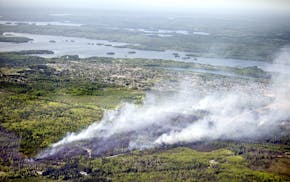DULUTH – About 1,000 fish, including hundreds of brook trout, have been found dead in Duluth's Tischer Creek.
The eastern Duluth creek empties into Lake Superior through the grounds of Glensheen Mansion, and is one of the city's designated trout streams.
The Minnesota Pollution Control Agency is investigating, and said in a news release the fish were likely dead from an abnormal cause. It was reported by a citizen and the city of Duluth after dead fish were found in the part of the creek that runs through Hunters Park. The city last week released up to 500,000 gallons of what it said was clean, potable drinking water into the stormwater system from a drinking water reservoir. Duluth treats its drinking water with chlorine.
In a news release, the city said it discharged water during a maintenance operation, and declined to comment further because of the investigation.
The Minnesota Department of Natural Resources and the MPCA have collected fish and water samples as part of the investigation. The MPCA said it has no evidence that nearby road construction led to the fish kill.
The dead fish were found along nearly two miles of the creek.
Brook trout are critical to a stream's ecosystem, and the only native stream trout species in the area, said Jeff Jasperson, a watershed ecologist for the MPCA.
Despite its urban setting, Tischer manages to stay cold enough for brook trout in most areas, he said, and because of success in natural reproduction, brook trout haven't been stocked by the DNR for many years.
Some of the city's trout streams have undergone extensive restoration efforts to combat warming and habitat and water access loss. City infrastructure such as undersized culverts can cut fish off from waterways and warm water hurts migratory fish populations that use Lake Superior tributaries as nursery areas.
Brook trout are especially susceptible to warm water, said Don Schreiner, a fisheries biologist with the University of Minnesota Sea Grant program.
While it's still unclear what killed such a high number of fish, it could take up to three years to repopulate the stream to previous levels, he said.

Man gets life in prison for 2023 stabbing death of vulnerable Waite Park woman

Charge: Twin Cities woman called sister as boyfriend was 'freaking out' before he killed her

YMCA in central Minnesota to pay $140K to settle claims manager sexually harassed female workers

Minnesota wildfire risk called 'critical' as weather service issues watch

